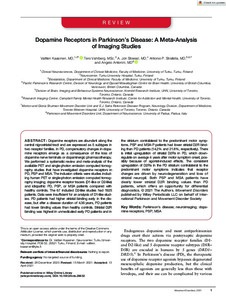Dopamine Receptors in Parkinson's Disease: A Meta-Analysis of Imaging Studies
Kaasinen Valtteri; Vahlberg Tero; Stoessl Jon; Strafella Vahlberg; Tero; Antonini Angelo
Dopamine Receptors in Parkinson's Disease: A Meta-Analysis of Imaging Studies
Kaasinen Valtteri
Vahlberg Tero
Stoessl Jon
Strafella Vahlberg
Tero
Antonini Angelo
WILEY
Julkaisun pysyvä osoite on:
https://urn.fi/URN:NBN:fi-fe2021093048816
https://urn.fi/URN:NBN:fi-fe2021093048816
Tiivistelmä
Dopamine receptors are abundant along the central nigrostriatal tract and are expressed as 5 subtypes in two receptor families. In PD, compensatory changes in dopamine receptors emerge as a consequence of the loss of dopamine nerve terminals or dopaminergic pharmacotherapy. We performed a systematic review and meta-analysis of the available PET and single-photon emission computed tomography studies that have investigated dopamine receptors in PD, PSP and MSA. The inclusion criteria were studies including human PET or single-photon emission computed tomography imaging; dopamine receptor tracers (D1-like or D2-like) and idiopathic PD, PSP, or MSA patients compared with healthy controls. The 67 included D2-like studies had 1925 patients. Data were insufficient for an analysis of D1-like studies. PD patients had higher striatal binding early in the disease, but after a disease duration of 4.36 years, PD patients had lower binding values than healthy controls. Striatal D2R binding was highest in unmedicated early PD patients and in the striatum contralateral to the predominant motor symptoms. PSP and MSA-P patients had lower striatal D2R binding than PD patients (14.2% and 21.8%, respectively). There is initial upregulation of striatal D2Rs in PD, which downregulate on average 4 years after motor symptom onset, possibly because of agonist-induced effects. The consistent upregulation of D2Rs in the PD striatum contralateral to the predominant motor symptoms indicates that receptor changes are driven by neurodegeneration and loss of striatal neuropil. Both PSP and MSA patients have clearly lower striatal D2R binding values than PD patients, which offers an opportunity for differential diagnostics. (c) 2021 The Authors. Movement Disorders published by Wiley Periodicals LLC on behalf of International Parkinson and Movement Disorder Society
Kokoelmat
- Rinnakkaistallenteet [27094]
